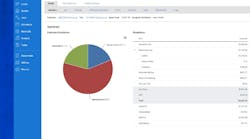In today’s world, it is common to hear that your business should be making “data-driven decisions.” Technology is advancing at a rapid pace, making it possible to harness data and use it to find new efficiencies in your vehicle fleet; however not every business has caught on. Owners of smaller fleets in particular may feel like they just do not have space in their budgets, but companies of every size can benefit from fleet management technology – which, in time, should provide a significant ROI.
Fleet tracking systems can be deployed by dealers to maximize their investment on service calls, and they can be leveraged as a value-add for clients.
How Fleet Management Technologies Work
Fleet management technologies encompass a wide range of features, and while GPS tracking is the most common, the best solutions go well beyond simple tracking. In addition to GPS, a comprehensive solution may include:
- Automated alerts and notifications;
- Cloud-based software that is accessible from mobile devices;
- Powerful reporting and access to historical data;
- Driver behavior tracking that monitors speeding and excessive idling;
- Route optimization and turn-by-turn directions;
- Maintenance tracking and scheduling; and
- Driver scheduling capabilities.
Fleet management technology uses a combination of software and hardware. The hardware is the actual tracking device that is installed on your vehicles – either openly via the OBD-II port or covertly without the driver’s knowledge. The software enables access to the data and automates aspects of fleet management. It should be intuitive and easy-to-use from any device for on-the-go management.
Six Ways Technology Maximizes a Vehicle Investment
1. Traffic and speed violations go down: Fleet tracking devices can be installed either covertly or overtly. Covert installation is not purely for hiding tracking from your drivers; in fact, I have found that in many scenarios, it is best to build trust with your employees by being open about the use of GPS tracking. Covert installation may be preferable because it keeps the device protected from tampering by thieves and also helps to keep the dashboard looking clean – although today’s devices are much more discrete than the cumbersome black boxes of days past.
On the other hand, simply knowing that you are being tracked is a major incentive for better driver behavior. In psychology, this is called the Hawthorne effect, and it means individuals tend to modify their behavior when they are aware they are being observed. Simply using fleet tracking may deter drivers from exhibiting the behaviors you want to monitor, and you will see traffic violations go down. Think of it as a gentle reminder to follow the rules of the road.
2. Better routing leads to reduced fuel costs: Taking an inefficient route wastes fuel. Drivers may take indirect routes because they feel comfortable with taking their sweet time, or they may simply not know a better way to get to their destination. Also, traffic incidents can result in unexpected delays that force drivers off the direct path they know. Fleet management technology that routes drivers on the best course and provides turn-by-turn instructions goes a long way. Another way to reduce fuel costs is through the behavior monitoring – both excessive idling and speeding burn up your fuel, singing your bottom line.
3. Better dispatch and response: When customers need emergency service or the assigned technician becomes unavailable, what is a fleet manager to do? Effective customer service relies on an agile system for dispatching technicians. Service calls can be a major source of frustration for customers who need to take off time from work and stay home while waiting for installation or repair service. This frustration only grows if the field technician gets caught up at another appointment and misses the window.
Planning for the unexpected is nearly impossible, but fleet management technology makes it easier by giving you a bird’s eye view of the location of each technician so you can dispatch the closest employee to customers in need. Customers also appreciate if you have the ability to keep them updated on how far away the technician is and when they’re expected to arrive. Transparency goes a long way toward ensuring the confidence customers have in your company.
4. Improved scheduling: Even when there are no emergencies, fleet management software can go a long way toward assisting with scheduling appointments for your technicians. Making a literal schedule is not the only way. As you collect more data about your fleet via GPS tracking, you get a better sense of how long technicians are spending on jobs, enabling you to schedule more effectively in the future.
5. More accurate invoices: Knowing how long technicians spend at jobs is vital when invoicing clients if you charge by the hour. It is never fun to dispute how long an employee was on-site when drawing up a bill. Fleet tracking software can show you how long a driver spent at any given job. Thanks to this technology, there isn’t room for debate because you have the evidence. It is also easier for managers to determine that drivers arrived on time if customers complain about lateness.
6. Keep vehicles in top shape: Staying on top of a maintenance schedule can be onerous, especially when your fleet consists of a mix of different makes and models. A one-size-fits-all solution simply will not do. If you veer from the necessary maintenance schedule for your vehicles, you face serious consequences like breakdowns that cost you time and money. If your fleet management software can send you reminders that are tailored to the make and model, you will be in a much better position. On-board diagnostic capabilities that allow the device to communicate trouble codes and daily status reports are key to helping your vehicles stay on the road.
Keeping Your Business Competitive
When security dealers implement fleet tracking technology, clients can trust that they are working with a company that makes use of modern technology to serve them better. Technology is here to help fleets achieve more efficient routing, better employee oversight, data-backed invoicing, and much more, so why not take advantage?
Fleet management solutions can pay for themselves. For smaller fleets in particular, a subscription model with no up-front costs makes it easier to get on board with high-tech solutions that you may think are only meant for large companies.
There is no need to get wrapped up in the minutiae of day-to-day fleet management – your time can be spent better elsewhere. Technology provides you with a better way of doing things so you can focus on what really matters for your business and propel your business ahead of the competition.
Shawn Welsh is VP of Marketing and Business Development for Telguard, whose sister company, SkyBitz Local Fleets, offers a fleet management solution. To request more information about the company, visit www.securityinfowatch.com/10215328.



